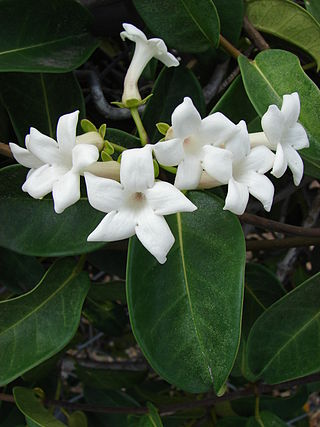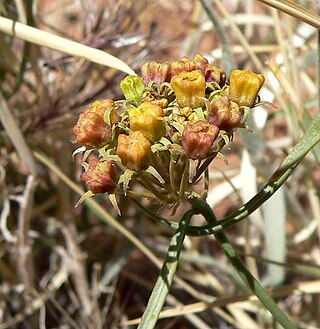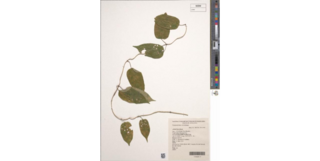
The Asclepiadoideae are a subfamily of plants in the family Apocynaceae. Formerly, it was treated as a separate family under the name Asclepiadaceae, e.g. by APG II, and known as the milkweed family.

Stapeliinae is a subtribe of flowering plants within the tribe Ceropegieae of the subfamily Asclepiadoideae of the family Apocynaceae. The subtribe comprises about 35 genera, including both the stem-succulent "stapeliads" and the horticulturally popular genera Brachystelma and Ceropegia. The largest number of genera are native to Africa, but a more limited number of genera are widespread in Arabia and Asia. Historically, a similarly circumscribed taxon was treated as a separate tribe, Stapelieae.

Cynanchum is a genus of about 300 species including some swallowworts, belonging to the family Apocynaceae. The taxon name comes from Greek kynos and anchein, hence the common name for several species is dog-strangling vine. Most species are non-succulent climbers or twiners. There is some evidence of toxicity.

Stephanotis is a genus of flowering plants first described in 1806. The name derives from the Greek στεφανωτής (stephanōtís) meaning, by sense, “fit for a crown”—from στέφανος (stéphanos), “crown”. It contains evergreen, woody-stemmed lianas with a scattered distribution in several tropical and subtropical regions.

Marsdenia is a genus of plants in the family Apocynaceae first described as a genus in 1810. It is named in honor of the plant collector and Secretary of the Admiralty, William Marsden. The plants are native to tropical regions in Asia, Africa, Australia, and the Americas.

Cynanchum socotranum, synonym Sarcostemma socotranum, is a species of plant in the family Apocynaceae. It is endemic to Socotra Island, south of Yemen. Its natural habitat is subtropical or tropical dry shrubland.

Funastrum utahense, synonym Cynanchum utahense, is a species of flowering plant in the genus Funastrum of the family Apocynaceae, known by the common names Utah swallow-wort and Utah vine milkweed. This relatively uncommon perennial vine is native to the Mojave Desert from California, Nevada, Utah and Arizona in the United States. This is a small vine with a highly branched, twining stem rarely exceeding a meter in length with which it physically supports itself on other shrubs and trees. It has small narrow leaves a few centimeters long. Its flowers are bright yellow to orange and grow in umbels. The fruit is a grooved follicle several centimeters long.

Edithcolea is a monotypic genus with a single species Edithcolea grandis. Once classified in the family Asclepiadaceae, it is now in the subfamily Asclepiadoideae of the dogbane family Apocynaceae. It is native to eastern Africa and to the Arabian Peninsula.

Leichhardtia flavescens, synonym Marsdenia flavescens, is a vine found in eastern Australia. Common names include hairy milk vine, yellow milk vine and native potato.
Dischidanthus is a genus of plants in the family Apocynaceae, first described as a genus in 1936. Species of the genus are native from the east Himalayas to south China and Peninsular Malaysia. It may be treated by some sources as a synonym of Marsdenia.
Pittosporum mackeei is a species of plant in the Pittosporaceae family. It is endemic to New Caledonia.
Paul Irwin Forster is an Australian botanist. He obtained his doctorate from the University of Queensland in 2004 with his thesis The pursuit of plants : studies on the systematics, ecology and chemistry of the vascular flora of Australia and related regions.
Vincetoxicum lineare is a species of plant in the family Apocynaceae native to Australia. Known as the bush bean, it is an edible species of plant found in arid regions. As Rhyncharrhena linearis, the species was at one time the only species in the monotypic genus Rhyncharrhena.
Vincetoxicum rupicola is a species of plant in the dogbane family Apocynaceae that is endemic to Queensland, Australia. It was first described by Paul Irwin Forster in 1992 as Tylophora rupicola.
Vincetoxicum forsteri is a species of plant in the dogbane family Apocynaceaethat is endemic to Australia. It was first described by Paul Irwin Forster in 1992 as Tylophora linearis.
Stephanotis arabica, synonyms including Dregea arabica and Marsdenia robusta, is a species of flowering plant in the family Apocynaceae, native to Socotra and mainland Yemen. It was first described by Joseph Decaisne in 1844.
Vincetoxicum cameroonicum is a species of flowering plant in the family Apocynaceae, native from Benin to Uganda in tropical Africa. It was first described by N. E. Brown in 1895 as Tylophora cameroonica.

Leichhardtia is a genus of flowering plants in the dogbane family (Apocynaceae). It includes 85 species native to mainland Australia, Papuasia, New Caledonia, and Lord Howe Island.

Leichhardtia liisae is a climbing plant in the Apocynaceae family, endemic to north-eastern New South Wales.

Orthosia scoparia, commonly known as the leafless swallow-wort, is a species of flowering plant in the genus Orthosia. It is an herbaceous vine with narrow opposite leaves. It is a host plant for the caterpillars of various butterfly species as well as Sephina gundlachii. It is in the Apocynaceae (Dogbane) family. It grows in the Southeastern U.S. and Caribbean and is native in the Bahamas, Cuba, Dominican Republic, Florida, Georgia, Haiti, Jamaica, Mississippi, Puerto Rico and South Carolina. A perennial it has yellowish / greenish white flowers. Caterpillars of the faithful beauty moth are thought to feed on it.












